Die alte Shantang-Straße zieht als eine der touristischen Attraktionen in Suzhou in der Provinz Jiangsu während der Sommerzeit viele Besucher an.
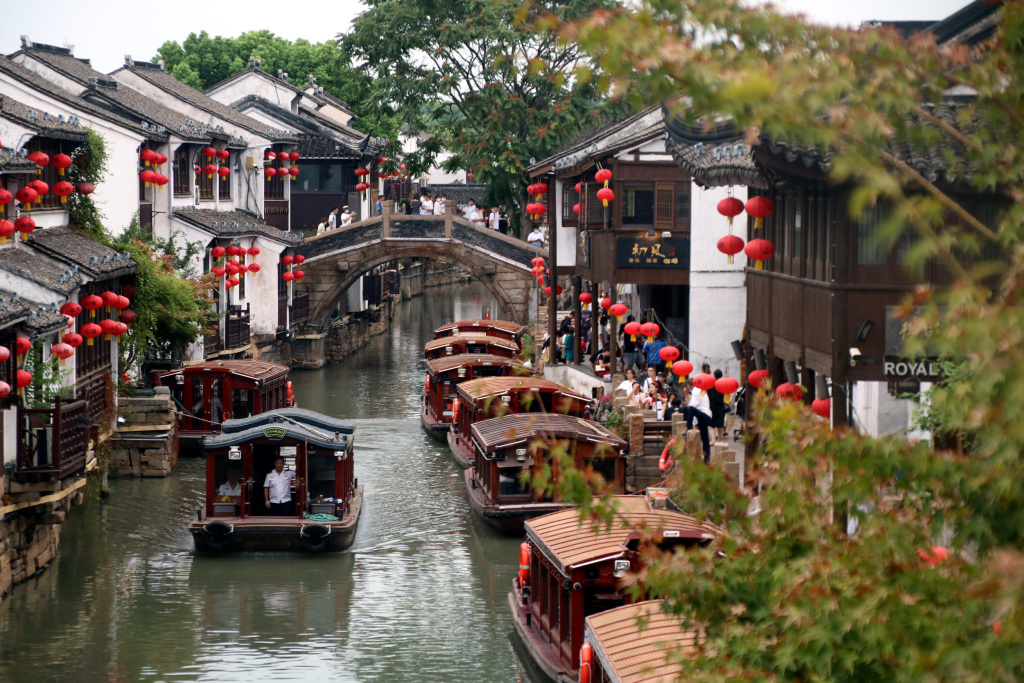
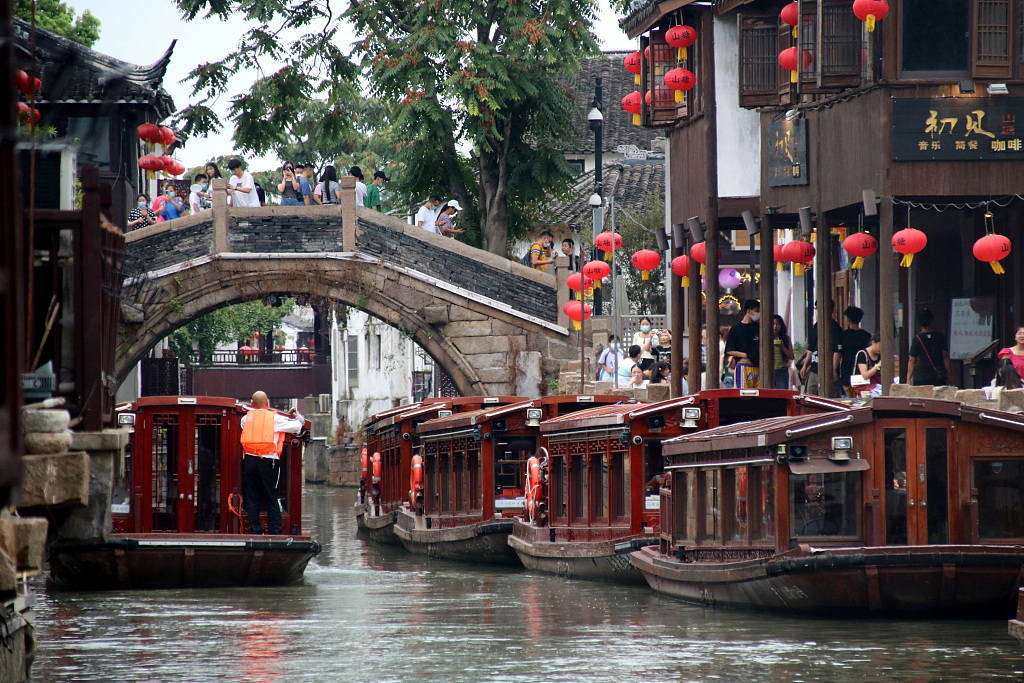

(Quelle: CRI Deutsch, VCG)
Die alte Shantang-Straße zieht als eine der touristischen Attraktionen in Suzhou in der Provinz Jiangsu während der Sommerzeit viele Besucher an.



(Quelle: CRI Deutsch, VCG)
„Wir haben den Weltrekord für automatisierte Be- und Entladevorgänge bei Anlegestellen neunmal gebrochen und sind weltweit führend bei automatisierten Anlegestellen. Dies ist auf die anhaltenden selbständigen Erneuerungen zurückzuführen.“ Dies sagte Zhang Liangang, führender Experte bei der Shandong Port Group Co,. LTD.
Im Jahr 2013 hat der Qingdao-Hafen beschlossen, eine vollautomatisierte Containeranlegestelle aufzubauen. Zhang Liangang, der sich zu diesem Zeitpunkt von einer Lungenkrebs-Operation erholte, wurde beauftragt, ein Team zur selbständigen Erneuerung anzuführen. Zhang erinnerte sich, im Herbst 1986 sei das elektrische Steuerungssystem eines Anlegestellenkrans am Qingdao-Hafen ausgefallen. Weil die Kernparameter von ausländischen Firmen beherrscht worden seien, hätten sie ausländische Experten für hohe Gehälter für die Reparatur einstellen müssen. „Dies hat mich tief beeindruckt. Wir haben viel Geld für die Ausrüstung ausgegeben, aber die Kernkomponenten und -technologien waren in den Händen anderer Menschen. Deshalb wurden wir noch von anderen kontrolliert und hatten keine anderen Methoden.“
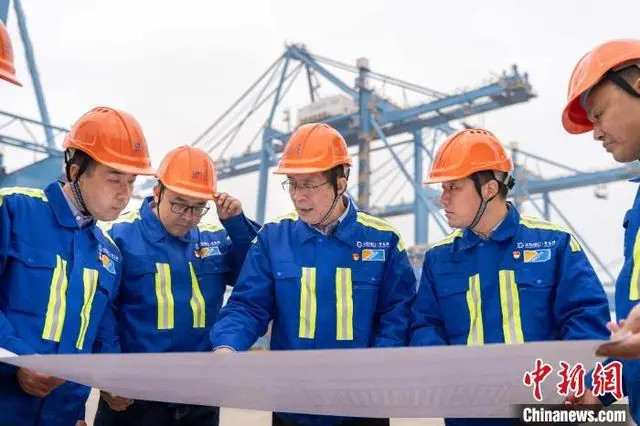
Zhang Liangang ist der Meinung, dass die automatisierten Anlegestellen ein notwendiger Weg des Aufbaus eines intelligenten Hafens sind. Aber es sei nicht leicht, von „Null“ an unabhängig Innovationen durchzuführen. In einem einfachen Containerhaus am Meer führte Zhang Liangang mit seinem Team rund um die Uhr technologische Erforschungen durch, um den Bau einer automatisierten Anlegestelle voranzutreiben, in welcher die fortschrittlichen Technologien wie das Internet der Dinge, Big Data, Cloud Computing und Künstliche Intelligenz zusammengeführt würden.
Zu jener Zeit ging Zhang Liangang tagsüber zur Baustelle, um die Bauarbeiten, die Stromversorgung sowie den Bau des Informationssystems zu überprüfen und leitete nachts Sitzungen für wissenschaftliche Erforschungen. Unvollständig gerechnet hat sein Team zu jener Zeit mehr als 3.000 Symposien organisiert und Hunderttausende Tests an Anlagen und Systemen durchgeführt.
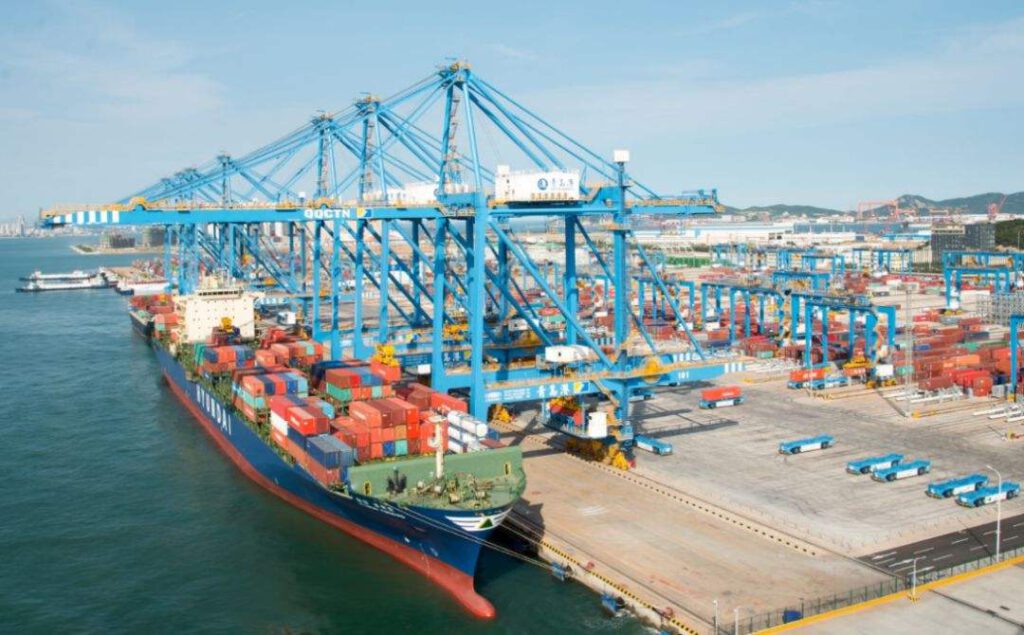
Innerhalb von zehn Jahren hat das Team von Zhang Liangang eine Reihe von technologischen Schwierigkeiten überwunden und eine Reihe von technologischen Standards ausgearbeitet. Sie haben vollautomatisierte Anlegestellen und 5G intelligente Anlegestellen mit selbständigem geistigem Eigentumsrecht fertiggestellt.
Daher haben die automatisierten Anlegestellen in China eine sprunghafte Entwicklung erlebt. Zhang Liangang hat damit seine Zusage erfüllt, „anhand der selbständigen Innovationen die automatisierten Anlegestellen der Chinesen selbst zu bauen.“ Er wurde als „Türöffner“ der chinesischen intelligenten Anlegestellen gekürt. Sein Team ist von anfangs zwei Mitgliedern auf heute 25 Mitglieder gewachsen. Sie sind durchschnittlich 34 Jahre alt und sind für wichtige Themen des intelligenten Hafenaufbaus zuständig.
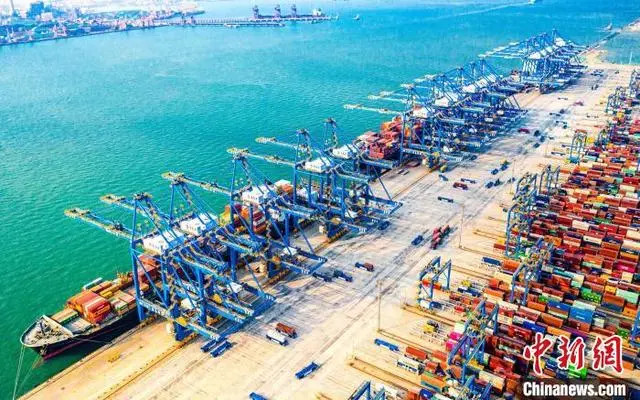
„Die technologischen Kerne müssen mit den eigenen Händen erfasst werden. Chinesen können durch eigene Weisheiten die Probleme lösen“, sagte Zhang Liangang. In Zukunft werden sie sich weiterhin für die Erforschung des intelligenten Betriebs der Anlegestellen einsetzen, um effizientere, umweltfreundlichere, ökologischere und sicherere Anlegestellen zu bauen, die besser für die Nutzung der Menschen geeignet sind.
(Quelle: CRI Deutsch)
„Ich bin in diesem Jahr 78 Jahre alt geworden. Wieviel Zeit ich noch übrig habe, das weiß ich nicht. Aber ich werde mein Versprechen – solange das Leben weiter geht, geht mein Dienst auch weiter – erfüllen.“ Das sagte Lu Shengmei, eine Kinderärztin, die sich ihr ganzes Leben der Kinderheilkunde gewidmet hat.
1968 absolvierte Lu Shengmei von der zweiten Medizinhochschule in Beijing. Danach verließ sie dem Aufruf der Zentralregierung folgend ihre Heimat und kam in den Kreis Jia im Norden der Shaanxi-Provinz an. Als eine gebürtige Beijingerin spürte sie gleich nach der Ankunft die große Kluft zwischen dem Leben in der Hauptstadt und in einem armen Kreis. „Der Kreis Jia war damals sehr arm. Das Wasser, das wir tranken, kam direkt vom Gelben-Fluss, und das Bett war aus Erde gemacht, Läusebisse waren auch nicht selten.“ Ein solches Leben war ihr völlig fremd. Trotzdem hat Lu sich bemüht, sich daran zu gewöhnen und der Arbeit als Kinderärztin zu widmen.
„In jenen Jahren lebten die meisten Menschen dort in Armut. Die Bauern waren fast schon gewohnt, sich bei Krankheiten nur auf das eigene Immunsystem zu verlassen, und haben wenige medizinische Kenntnisse. Viele Patienten, die in Bergregionen lebten, konnten nur schwer ihren Wohnort verlassen“, sagte Lu Shengmei. Deshalb hat sie sich oft Zeit genommen, in die Dörfer zu gehen und Vor-Ort-Behandlungen zu liefern.
Einmal ist sie eine Stunde lang in der Nacht gelaufen, um einer Frau bei der Geburt zu helfen. Als sie ankam, sah sie, dass im dunklen Licht eine Gebärde auf einem Sack voller Erde saß und das Baby schon neben seiner Mutter lag. Die Leute daneben wollten gerade mit einer geschwärzten Haushaltsschere die Nabelschnur durchtrennen. Lu hat das sofort gestoppt und mit desinfizierten Instrumenten und Bandage die Mutter und ihr Kind behandelt.
Dieses Erlebnis ist Lu Shengmei unvergesslich. Das medizinische Wissen der Menschen dort sei so unzureichend und die medizinischen Bedingungen so rückständig. Da habe sie gedacht, das sei der Ort, wo sie am meisten gebraucht werde. Sie entschied sich, sich dafür einzusetzen, die medizinischen Bedingungen in dem armen Kreis zu verbessern und medizinisches Wissen unter den Leuten zu verbreiten.
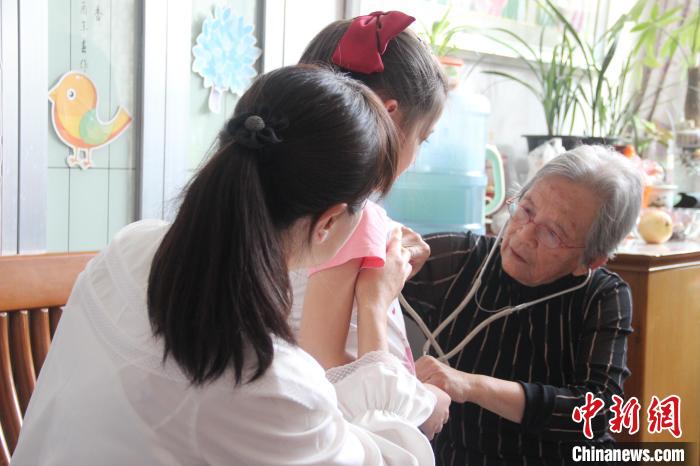
Um die kranken Kinder professioneller und wirksamer behandeln zu können, hat Lu Shengmei sich bemüht, im Krankenhaus des Kreises Jia eine unabhängige Abteilung für Kinderkrankheiten zu gründen. Dafür hat sie unermüdlich die Notwendigkeit und Bedeutung einer unabhängigen Abteilung hervorgehoben. Im Jahr 1983 war es ihr endlich gelungen. Das war aber nur der erste Schritt. Um die Fähigkeiten der Krankenschwestern in der Abteilung zu erhöhen, hat sie sich wieder bemüht, diese in die Provinzhauptstadt Xi’an zur Ausbildung zu schicken, manchmal sogar mit ihrem eigenen Geld. Zudem ging Lu oft mit ihren Kollegen in die Gemeinden und Dörfer, um die Ärzte dort auszubilden, planmäßige Kinderimpfungen vorzustellen und medizinische Grundkenntnisse zu verbreiten.
„Im Kreis Jia kennt fast jeder die Adresse und Telefonnummer von Dr. Lu. Und alle Familien sind bereit, Kinder von ihr behandeln zu lassen, wenn sie krank sind, und sogar Leute aus der Umgebung vom Kreis Jia kommen zu ihr“, sagte Zhao Lingling, Mutter eines kranken Kindes, „Dr. Lu hat nicht nur ausgezeichnete medizinische Fähigkeiten, sondern geht auch sehr rücksichtsvoll mit ihren Patienten um. Sie beharrt seit vielen Jahren auf dem Grundsatz, dass Kranke behandelt werden können, ohne Geld ausgeben zu müssen, und schwere Kranke mit weniger Geld zu behandeln sind. Zudem wird sie Antibiotika und Stärkungsmittel niemals wahllos einsetzen.“
„Schwester Lu“, „Tante Lu“, „Oma Lu“ „Dr. Lu“… wenn Lu Shengmei auf der Straße des Kreises Jia geht, wird sie immer wieder von den Menschen begrüßt. Viele Generationen lokaler Familien wurden von ihr behandelt, was sie zu einer „alten Bekanntin“ und manchmal sogar zu einem „Familienmitglied“ der Leute gemacht hat.
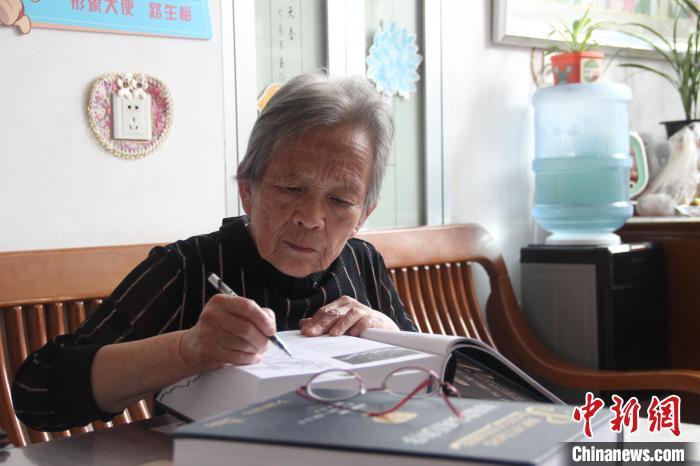
Im Jahr 1999 trat Lu in den Ruhestand. Sie lehnte ein hohes Gehaltsangebot eines großen Krankenhauses ab und entschied sich, weiter im Kreis Jia zu bleiben. Im Krankenhaus und von Zuhause hat sie wieder begonnen, ehrenamtliche medizinische Arbeit zu leisten. Als Ärztin habe sie keinen Ruhestand bei der Linderung der Leiden der Patienten, sagte sie. Solange sie noch arbeiten könne und die Patienten sie immer noch bräuchten, werde sie weiter ihre Arbeit machen.
(Quelle: CRI Deutsch)
The arrival of 1 October 2022 marks the 73rd anniversary of the founding of the People’s Republic of China (PRC). Through the impact of the COVID-19 epidemic and the dramatic changes in the international political landscape in recent years, the uniqueness of this country is becoming more and more evident.
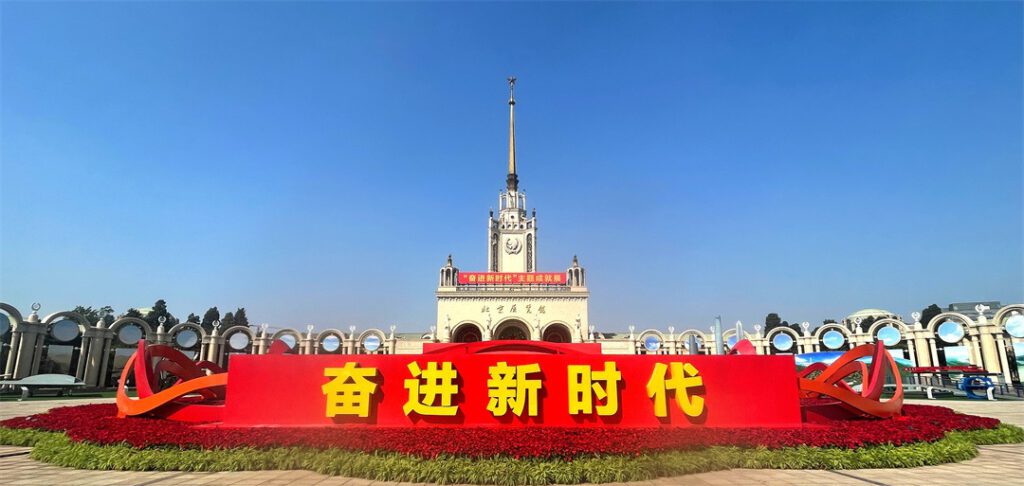
At its inception in October 1949, PRC was new primarily because it was a People’s Republic. In Chinese history, this new national identity distinguished it not only from the successive imperial dynasties, but also from the recently overthrown Republic of China; in the world, it distinguished it not only from the de facto empires of the United States and the Soviet Union but also from the substantive republics of capitalists, aristocrats, plutocrats or warlords; it was a completely new kind of state.
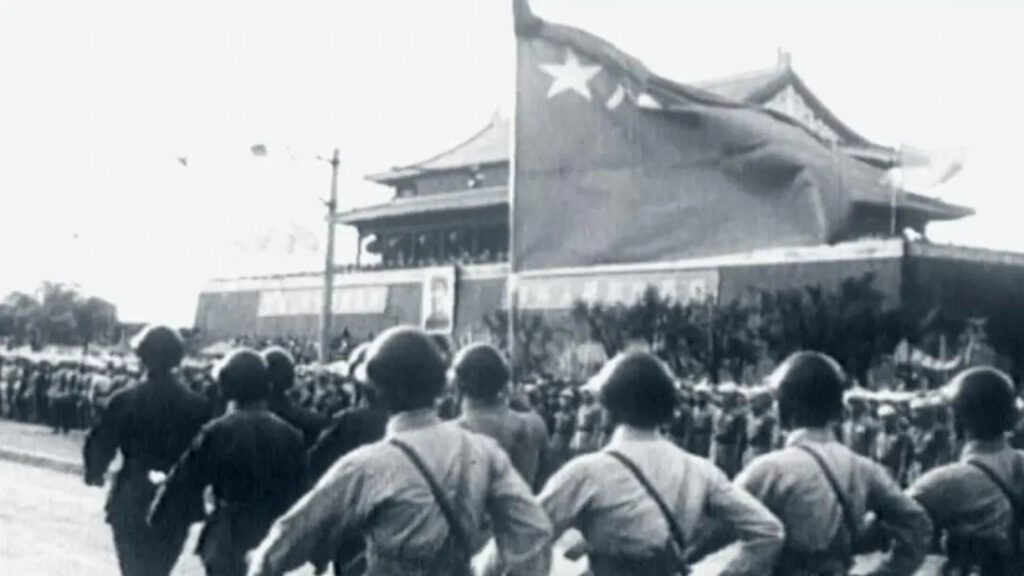
The names of the People’s Revolution, the People’s War, the People’s Republic, the People’s Congress, the People’s Political Consultative Conference, the People’s Government, the People’s Army, the People’s Police, the People’s Bank, and the RMB ……, which the Chinese people had long taken for granted, were all distinct political proclamations to the world at the time of their birth: the true People’s Republic was established.

Starting from the brink of failure, the road to success was destined to be long and rocky. At the meeting in Xibaipo in early January 1949, Mao Zedong sketched out a blueprint for this road: “The Communist Party of China will complete the task of national revolution in twenty-eight years, plus two more years, that is, shoveling the foundation takes thirty years, but starting a house will take decades of work. “
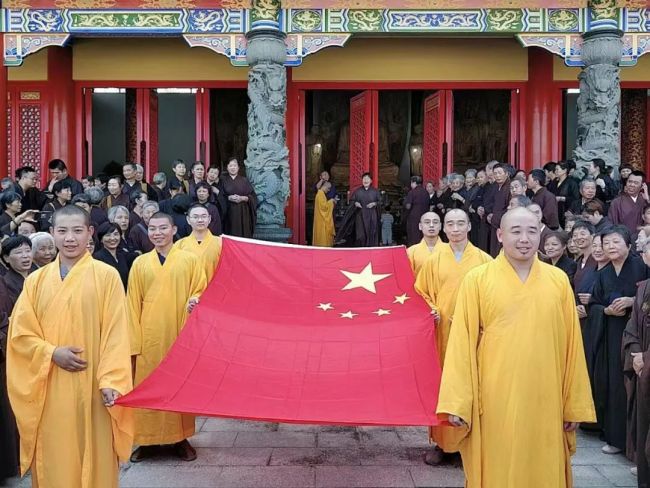
History has witnessed that China’s journey of more than 70 years is full of dangers of failure. To succeed, the new state must break through the layers of powerful defenders of the old order.
The miracle, however, is that the Chinese people never doubted that their new state would succeed. In the most difficult period of the decade after the founding of China, even though there was a serious economic recession and the gap between China and the developed countries grew wider for some time, China’s leaders never lost their conviction for a moment that socialism would surpass capitalism and that China would surpass the U.S.

This was not blind arrogance; this was the confidence in China that came not only from the Chinese people themselves but also from some international figures with insightful ideas who also predicted that China would soon achieve great success.
When British Field Marshal Bernard Law Montgomery visited China in 1960, he said during a meeting with Mao Zedong: “I have an interesting question for the President. What will be the fate of China fifty years from now? By that time China will be the most powerful country in the world.” Montgomery was a personal witness to the rise and fall of the British Empire, and what he called “fifty years” was a very short time scale in the cycle of great power history, in other words, he was sure that China could become “the most powerful country in the world” in a very short time.
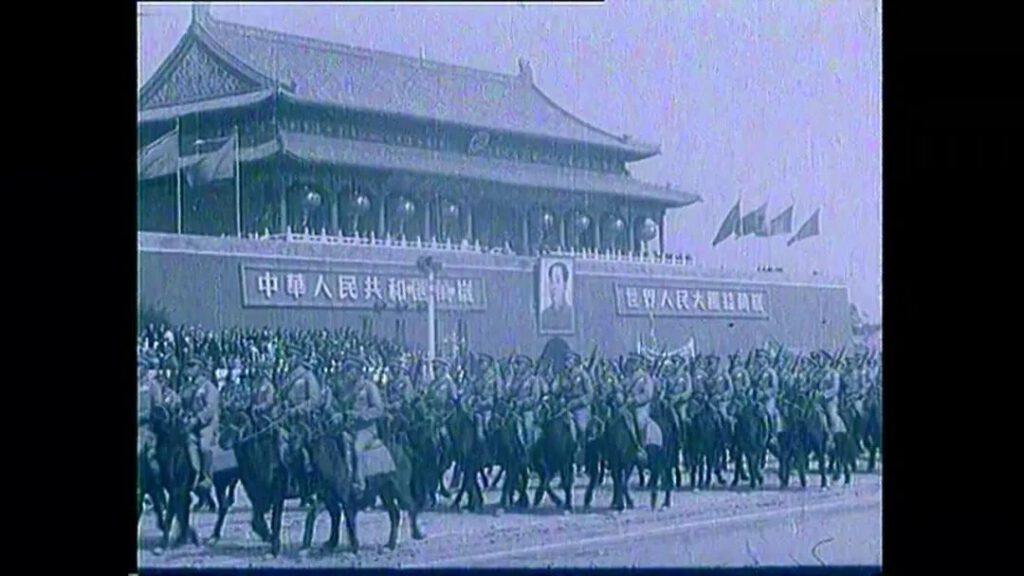
Another foreigner who knew more about China, the American author Pearl Sydenstricker Buck, who grew up in China and won the Nobel Prize in Literature for her novels about Chinese life, expressed similar sentiments. In a 1962 speech she said, “The Chinese people are superior, and I know that when the Chinese people decide to adapt themselves to modern life as the rest of the world now knows it, they will do so with lightning speed…… China will soon take its place as one of the greatest and proudest of all nations.”
The uniqueness of the PRC was mainly reflected in the new statehood in the early years of its founding, in the miraculous confidence in its history of more than 70 years, and more in the present time when this new statehood has moved with lightning speed to success and has quickly become one of the greatest and proudest countries.

And the mutual reinforcement of confidence and success leaves no doubt about China’s steady march on its current path, and no doubt about its bright future. Is China’s response to the COVID-19 epidemic of the last three years the right way to go? Will China’s steady economic growth continue in the long run? Can China’s high-quality development succeed? Will the visionary goals China has set for 2035 and 2049 be achieved on schedule? The answers to these questions do not require much detailed analysis and can be given with great certainty by knowledge of the 70-year history of China.
It is in this situation that another international reaction emerges, where predictions of China’s success are no longer interpreted as wishes, but as warnings ahead of time, and the reality that China is succeeding is no longer interpreted as a trend, but as an early threat.
To some in the West, the very event of China’s world-class success as a People’s Republic is completely unacceptable. In addition to the apparent competition in terms of comprehensive national power, geopolitics, and ideology, it has also given rise to a deep and invisible competition in terms of “national success”.

For a long time, there has been an internationally popular set of specialized theories produced by Western academia to explain the reasons and justifications for why the West is so rich, why it can be a model for other countries, and why it is bound to dominate the world.
The global bestsellers released by the world’s leading universities have influenced many people, especially intellectuals and policymakers in developing countries who want to make their countries rich and strong as soon as possible, and who are so eager to find the true lessons from these books on how the West became rich and strong. Frankly, these books are nothing more than a big success story, no different from the various best-selling books on the market that sell personal or corporate success secrets.

The content of the books on “Western success” varies widely, but the underlying theme is the same: to downplay as much as possible the fundamental dynamics of Western imperialism in history, to avoid the fundamental factor of the West’s “ability to seize land and labor by violence,” and to present the West’s current wealth and status as the most important. It is to attribute the West’s current wealth and status to the uniqueness of Western culture, which has been pieced together, and to the inherent ills of non-Western cultures.
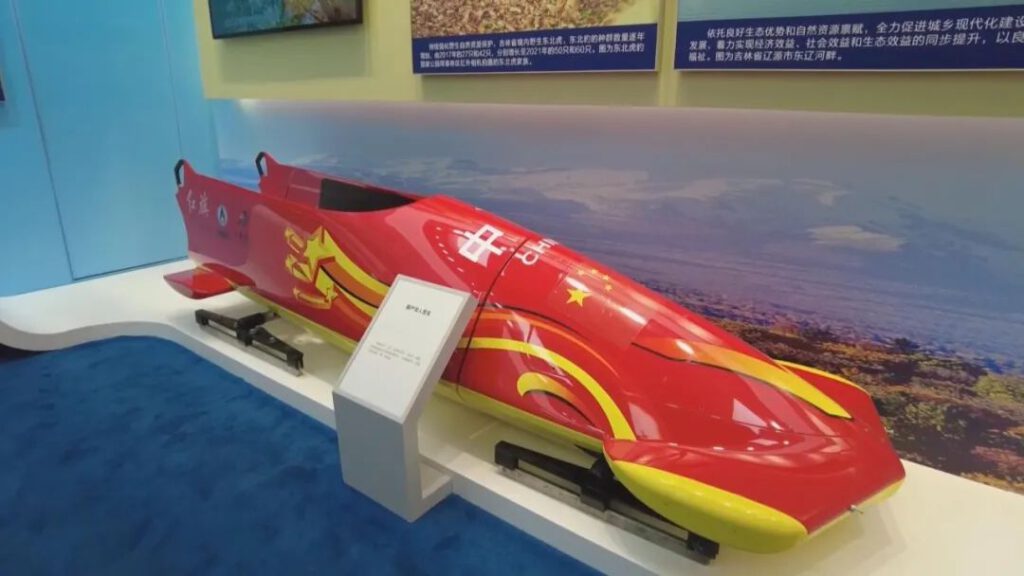
If there were no China in the world, if China, a non-Western, non-imperialist, non-colonialist, non-capitalist, genuine People’s Republic, had not succeeded in its rapid rise and its Chinese modernization, then world history might well have “ended” in this way, in the West’s permanent domination of the world and the global distribution of wealth in which the West gets richer and the non-West gets poorer.
But, contrary to the West’s wishes, the real story of China’s success debunks the myth of Western success and declares the illegitimacy of Western domination of the world and the falsity of the Western version of the world history narrative.
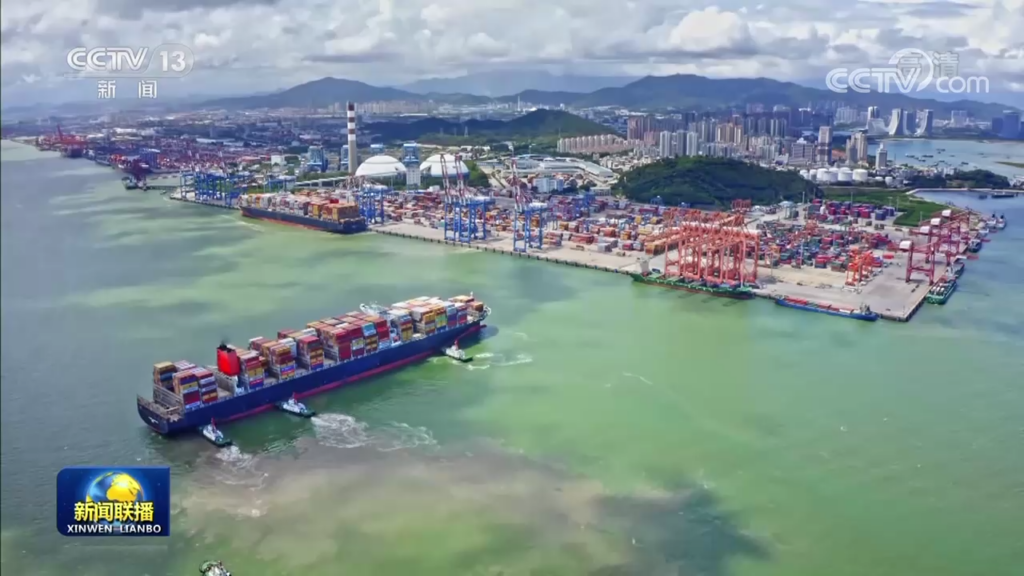
From the perspective of modernization, from the initial stage of “modernization equals Westernization” to the current stage of “modernization does not equal Westernization”, a “de-Westernized modernization” stage has gradually emerged as a result of China’s success.
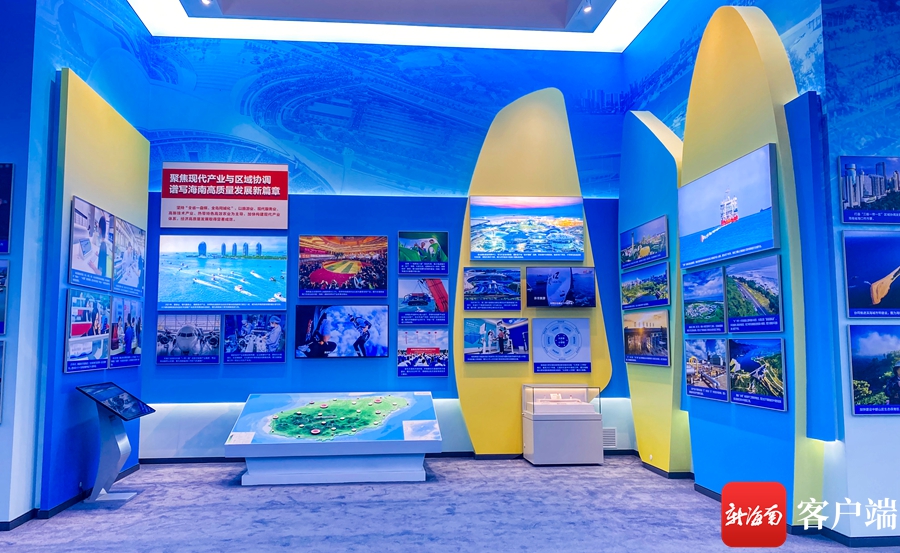
This is the unique and profound effect that today’s China has on the world. The very fact of China’s success as a model, and the contrast between this non-Western model and the West’s use of itself as a model, is changing the world’s perception of the past, the present, and the future every day. China’s continued success is part of the great changes that have not been seen in a hundred years.
(Source: People, Xinhua, lzbs)
Die chinesische Lebensmittellandschaft ist in ihrer unendlichen Vielfalt ein Universum, in dem die Produkte der chinesischen Erde, zarte Bambussprossen, fette Enten, duftendes Sesamöl, sehr salzige Sojasoße, frischer Ingwer… unersetzlich sind und wo die Methoden des Anbaus, der Ernte, des Schlachtens, des Schneidens, des Zubereitens, des Kochens und der Tischmanieren mit unseren nicht zu vergleichen sind. Ein Versuch eines Panoramas?
Natürlich ist eine vollständige Bestandsaufnahme unmöglich. Zumal jede Region, jede Stadt, jedes Dorf eine kleine Welt ist, deren Küche einzigartig ist. Wobei sie alle ihre eigenen Regeln haben.
Der chinesische Esser lebt abwechselnd in Zwang und Freiheit. Zwang ist das Essen in fester Form, das zu den genannten Zeiten serviert wird; Freiheit, zwischen den Mahlzeiten, schlägt die Zeit, aber nicht ein gastronomisches Vakuum.

In China gibt es viele Möglichkeiten, sich auch außerhalb der täglichen Mahlzeiten den Magen angenehm zu füllen. An der Straßenecke, am Ausgang des Kinos, auf dem Weg zur Schule, kannst du die Straßenverkäufer nicht übersehen, die knusprige Donuts, weiche kleine Kuchen, schmelzende Reisbällchen, herzhafte und süße Suppen, kalte oder heiße Suppen, Frühlingszwiebel- oder Rübenpfannkuchen, saftige Ravioli, Sesamnougat, gepuffte Reisblüten, duftenden Aufschnitt anbieten. das alles wird in kleinen Portionen angeboten, ganz nach Wunsch, und lädt dazu ein, dem eigenen Magen zu folgen und die kleinen Vorlieben zu pflegen.
Dieses Street Food, Spezialitäten einer Provinz oder einer Stadt, die niemals zu Hause zubereitet oder gegessen werden, sind das Symbol der individuellen Freiheit, die sich in der stummen Freude über die ohne Rechenschaft verzehrte Mahlzeit ausdrückt.

In den 1970er Jahren ging diese Philosophie der Straßenstände zweifellos etwas verloren.
Aber heute haben Appetit und Gastronomie ihre Rechte zurückgewonnen und der neugierige Wanderer kann, wo immer er ist, seine Geschmacksnerven bis zum Brechreiz trainieren.
Das Naschen zu jeder Tageszeit verhindert keineswegs das Essen zu einer festen Zeit nach einem genau festgelegten Muster.
Dort wird ein „Grundnahrungsmittel“ (meist Reis, Nudeln oder Weizenbrötchen in den nördlichen Regionen) von „Zweitnahrungsmitteln“ (Fleisch- und Gemüsegerichten) begleitet, auf die eine Suppe folgt – das sind in der Tat die typischen Bestandteile einer normalen chinesischen Mahlzeit.
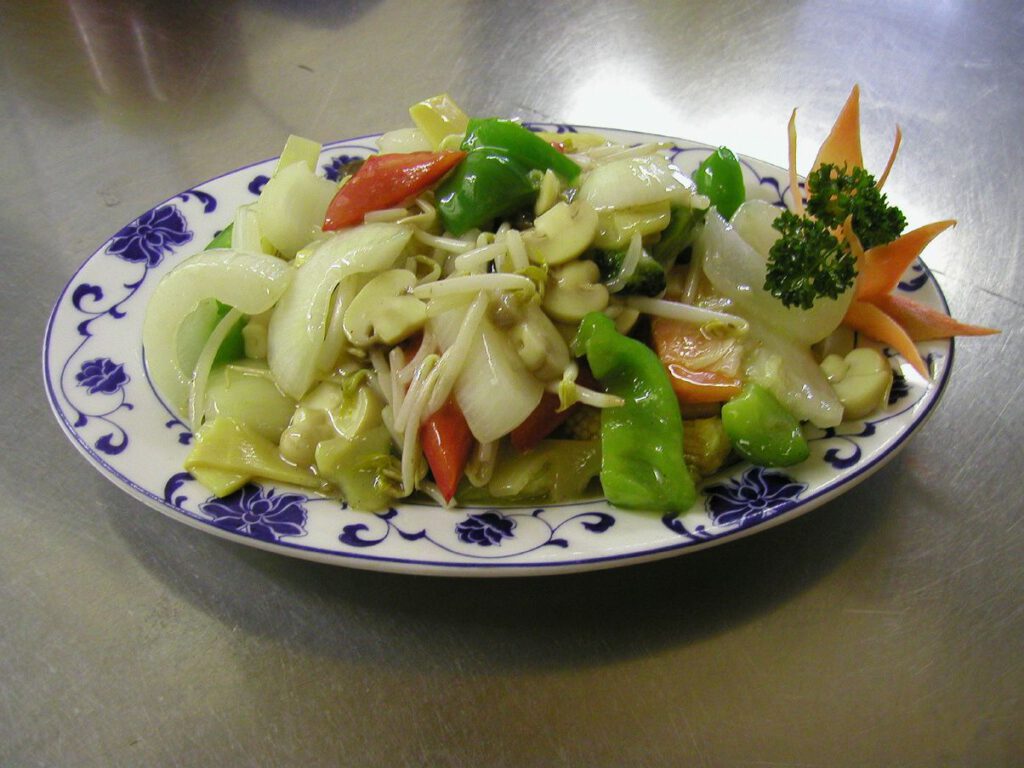
Der Preis, den wir der Stärke beimessen, die als grundlegend gilt, weil sie wirklich nahrhaft ist, im Vergleich zu den Beilagen, die als weniger notwendige Handlanger gedacht sind, zeigt sich deutlich in der Frage, die dir oft am Ende einer Mahlzeit gestellt wird: „Wie viele Portionen Reis hast du gegessen? »
Auf der anderen Seite scheint diese Ordnung auf der höchsten Ebene der Gastronomie zusammenzubrechen. Ein Festmahl besteht aus „sekundären“ Nahrungsmitteln, denen durch ihre Anzahl, Vielfalt und Fülle die Hauptrolle zukommt. Sie werden zu Hauptgerichten, von denen wir satt werden müssen, während Reis in einer Umkehrung der Werte am Ende der Mahlzeit serviert und nicht verzehrt wird. Ihn zu essen wäre eine Beleidigung für den Gastgeber und würde bedeuten, dass das Festmahl nur mittelmäßig ist.

Es geht also nicht nur darum, gut zu essen, sondern auch darum, die Wahl zu haben, nicht alles zu essen, um das Beste zu genießen… „die königlichen Stücke“. Denn für den Feinschmecker besteht eine gute Mahlzeit darin, „sich von Aromen zu ernähren“. Es ist also nicht ohne eine bestimmte Anzahl von Gerichten und Gästen denkbar, die Anzahl hängt nämlich von der Vielfalt ab. Diese Auswahl an Geschmacksrichtungen wird durch die Struktur des Menüs in mehreren Gängen angeboten. In Suzhou sind es zum Beispiel sechs.
Ein Festmenü ist so aufgebaut, dass es von kleinen Vorspeisen, die eher eine dekorative Funktion haben, über große Stücke, die den Höhepunkt des Ganzen darstellen, bis hin zu gebratenen Gerichten reicht, deren Frische und Köstlichkeit den Appetit auf das Folgende aufrechterhält. Dazwischen gibt es süße und leichte Zwischengerichte, die einem eine Verschnaufpause gönnen. Auf die großen Stücke folgen die „Desserts“, Variationen oder Vorspeisen, die oft aus kleinen herzhaften oder süßen Gebäckstücken bestehen, deren Aufgabe es ist, den Geschmack abzulenken.

Die Geschmacksknospen werden ausgiebig umworben.
Eine leichte Brühe mit wenig ausgeprägtem, aber delikatem Geschmack spült den Mund und fördert die Verdauung. Ein paar Tassen guter Tee runden das Ganze ab.
Jeder Gang muss aus einer Reihe von Gerichten bestehen, deren Abfolge dem Gast das angenehme Gefühl vermittelt, das Inventar der einfachen Geschmacksrichtungen (salzig, süß, sauer, bitter, scharf) und deren Kombinationen ausgeschöpft zu haben. Auf diesem Karussell der Geschmäcker, das den Gaumen erfreut, sind alle Sinne eingeladen, die Farben, die Düfte, die Aromen und das Volumen der Elemente jeder Zubereitung zu schätzen, deren innere Harmonie gleichzeitig mit der der anderen Gerichte übereinstimmen muss.
Wenn wir so viel Wert auf die Vielfalt der Geschmäcker und ihre Harmonie legen, dann deshalb, weil wir es mögen, wenn sie sofort wahrnehmbar, kontrastreich und sehr verschieden voneinander sind. Sojasoße, Ingwer, Frühlingszwiebeln und Sesamöl, Gewürze, die überall in der Region verwendet werden, sowie die spezifischen Gewürze der jeweiligen regionalen Küche sind stark. Die dezente Verwendung von Sojasoße ist wenig sinnvoll.

Sie ist zwar sehr salzig, aber sie wird verwendet, um einen bestimmten Geschmack zu erzielen und nicht um Salz hinzuzufügen. Der Geschmack sollte im Mund explodieren, aber letztlich hängt er von der Kombination der natürlichen Aromen gekochter Lebensmittel, dem Duft duftender Pflanzen und dem Aroma vorgefertigter Gewürze ab. Der kulinarische Akt der Chinesen besteht darin, diese drei Geschmacksrichtungen zum richtigen Zeitpunkt zu kombinieren, aber abgesehen von einer Stärkebindung gibt es keine wirkliche Endbearbeitung der Soßen, wie es in der guten französischen Küche der Fall ist.
Ein Festessen ist auch der Ort, an dem außergewöhnliche Lebensmittel gegessen werden, die je nach Region auf ganz unterschiedliche Weise zubereitet werden: Haifischflossen, Schwalbennester, Seegurken, Wild, Abalone, Bärenpalmen usw., um nur die bekanntesten zu nennen, sind für große Mahlzeiten das, was Trüffel, Kaviar und Gänseleber für unsere Silvestermenüs sind.

Wenn bei förmlichen Mahlzeiten die Anordnung der Gäste und der Ablauf einer Reihenfolge folgen, scheinen die Tischmanieren nicht so restriktiv zu sein wie die in unseren europäischen Höflichkeitshandbüchern. Wenn man verstanden hat, dass die Teller allen Gästen zur Verfügung stehen, dass man abwechselnd in jeden Teller picken muss, ohne zu versuchen, einen vor dem anderen leer zu essen, und dass man den Umgang mit den Stäbchen beherrscht, hat man das Glück in der Hand.
Scheinbar unauffällige, leichte und lächerliche Instrumente – es sei denn, sie sind aus Edelmetall oder seltener Jade gefertigt! Die Stäbchen bedingen die kulinarischen Vorgänge und geben ihnen eine Bedeutung. Die in der Küche durchgeführten Schnitte, Zuschnitte, Meißelarbeiten, das Vorkochen und das spezifische Garen werden durch ihre Verwendung notwendig. Nur Lebensmittel, die mit Stäbchen gegriffen, eingeklemmt, zerrissen oder gelockert werden können, kommen auf den Tisch. Der Tisch, ein Ort, an dem Geselligkeit zum Ausdruck kommt, erlaubt nur den Gebrauch dieser harmlosen Instrumente und überlässt der Küche das, was sticht und zerreißt, um Substanzen in verzehrbare Lebensmittel zu verwandeln.
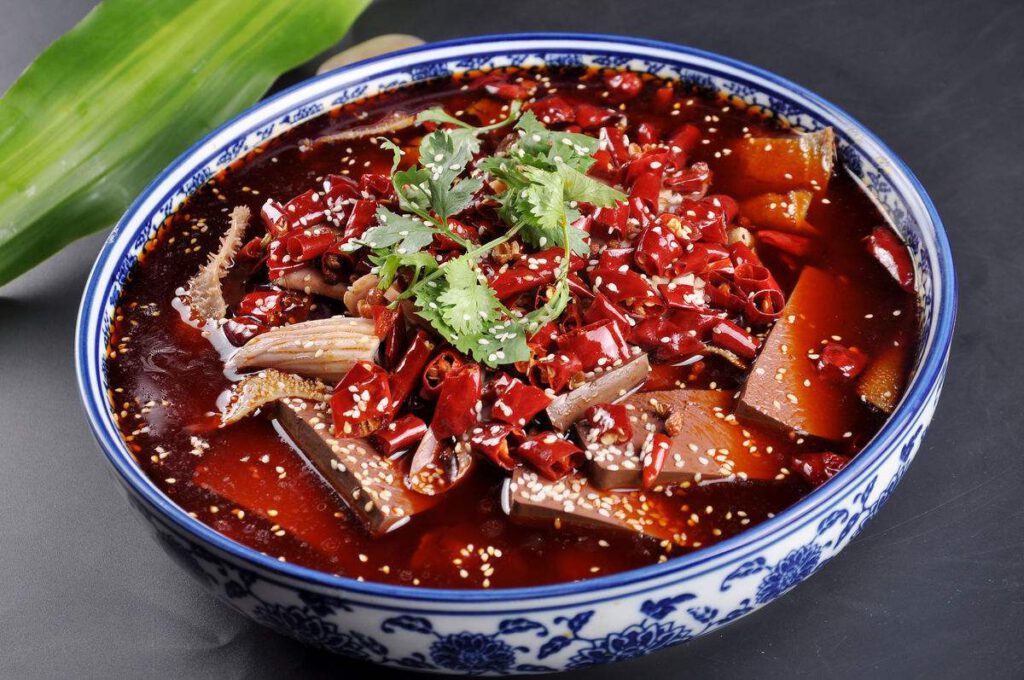
In einem der nächsten Artikel werden wir über Farben und Texturen in der chinesischen Küche sprechen. Ein großes Kapitel!
Die chinesischen Behörden kämpfen aktuell mit Recht gegen die Verschwendung. Aber die chinesische Haute Cuisine weckt immer Begehrlichkeiten und kristallisiert Träume. Es liegt an uns, Genuss und Mäßigung zu verbinden.
In einer Grundschule im ostchinesischen Qingdao erleben Kinder den Charme der TCM, indem sie verschiedene Heilkräuter kennenlernen.
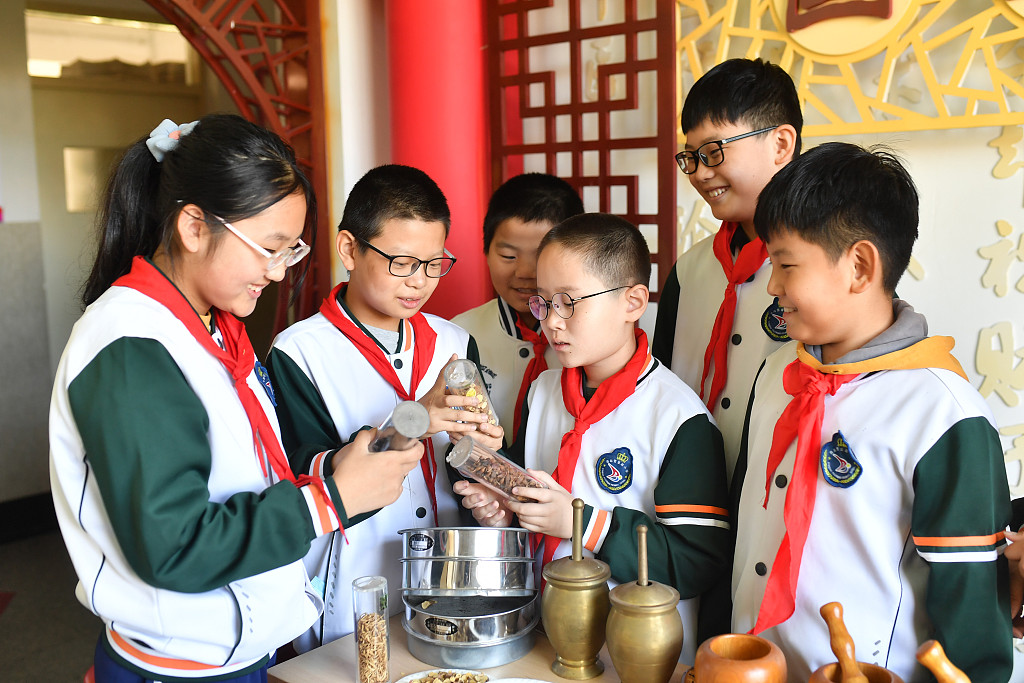
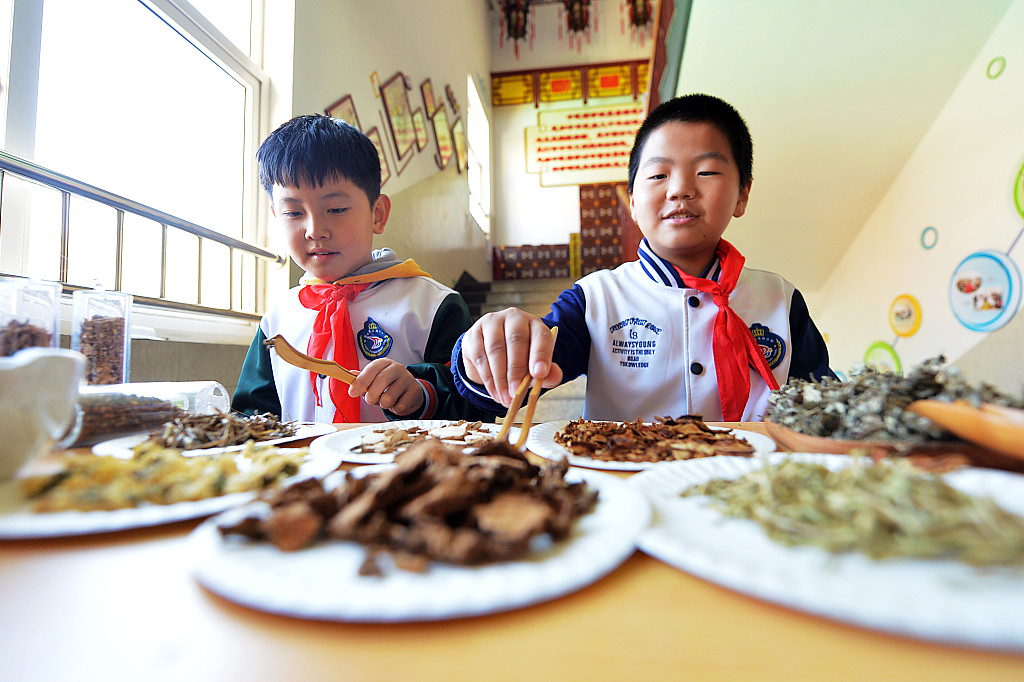
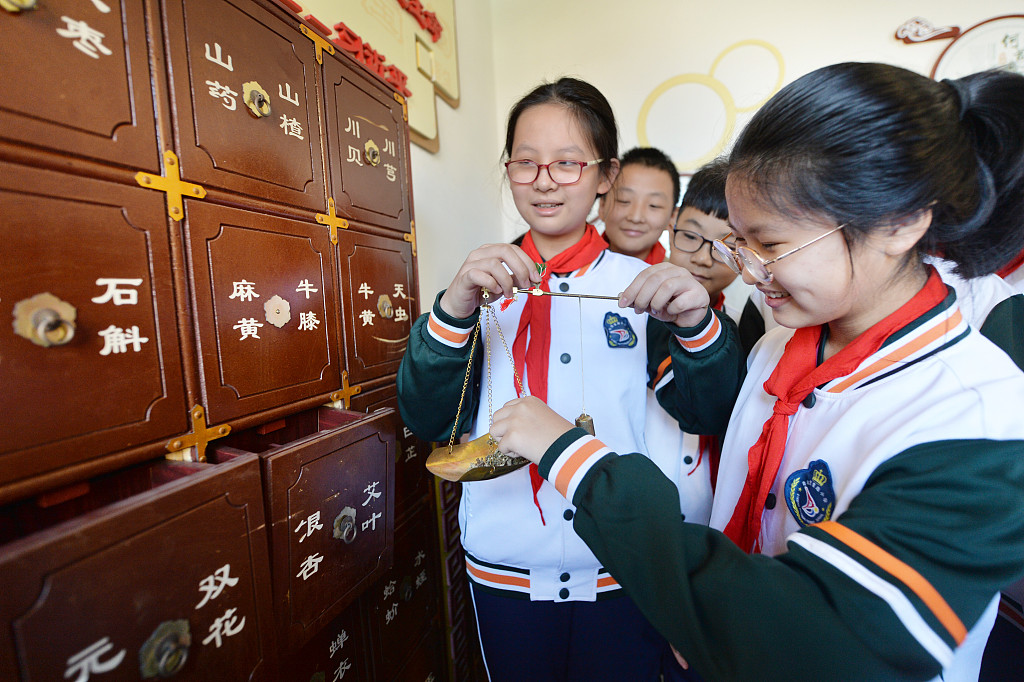
(Quelle: CRI Deutsch, VCG)
Die Gebirge in der nordostchinesischen Stadt Shulan sind von Herbstblättern rot gefärbt. Die saisonbedingte Landschaft kann allein durch Fotos beruhigend wirken und den Kopf frei machen.

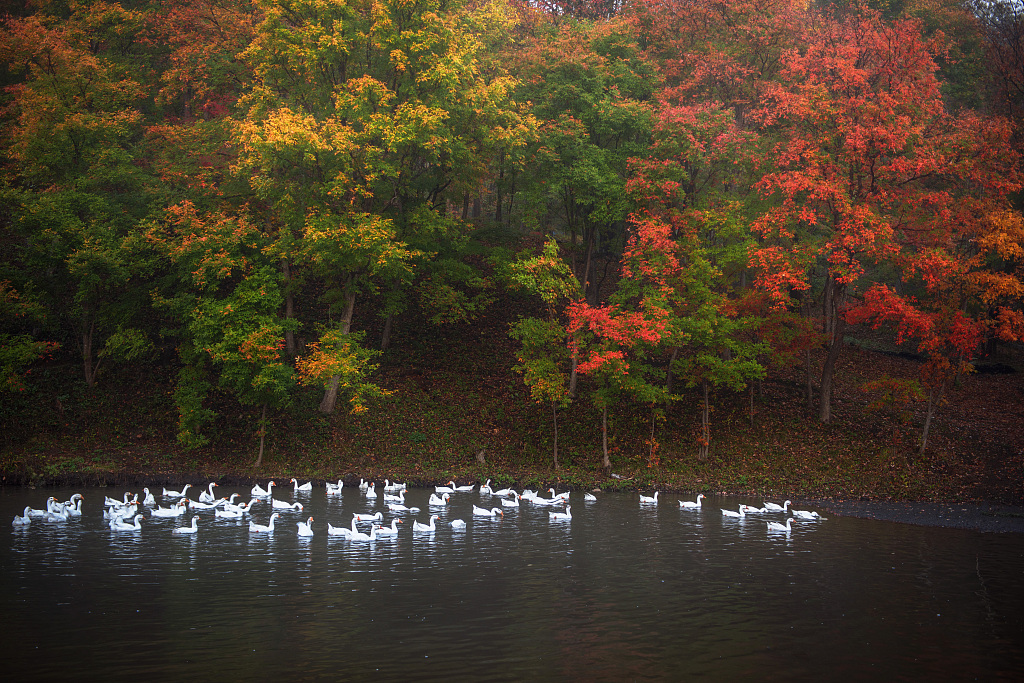

(Quelle: CRI Deutsch, VCG)
Chinas Staatspräsident Xi Jinping und Deutschlands Bundespräsident Frank-Walter Steinmeier haben am Dienstag Glückwunschbotschaften zum 50. Jahrestag der Aufnahme diplomatischer Beziehungen zwischen beiden Ländern ausgetauscht.
Xi Jinping wies darauf hin, dass China und Deutschland in den letzten 50 Jahren ihre Beziehungen im Geiste des gegenseitigen Respekts und des gegenseitigen Nutzens weiter gefördert und positive Beiträge zum Weltfrieden und zur Entwicklung geleistet hätten, indem sie ein Kapitel gemeinsamer Erfolge schrieben. Er messe der Entwicklung der chinesisch-deutschen Beziehungen große Bedeutung bei und wolle mit Bundespräsident Steinmeier zusammenarbeiten, um den 50. Jahrestag der Aufnahme diplomatischer Beziehungen zum Anlass zu nehmen, auf der Vergangenheit aufzubauen und die umfassende strategische Partnerschaft beider Länder zum Nutzen beider Länder und Völker auf eine neue Ebene zu heben, so Xi Jinping weiter.
Steinmeier erklärte, dass sich die deutsch-chinesischen Beziehungen in den letzten 50 Jahren in vielen Bereichen vertieft hätten, was den Austausch zwischen beiden Ländern und das Wohlergehen der beiden Völker fördert. China sei der größte Handelspartner Deutschlands, und die deutsch-chinesische Wirtschafts- und Handelskooperation liege im Interesse beider Seiten. Er wünsche, dass die Zusammenarbeit zwischen den beiden Ländern weiter gedeihen werde.
(Quelle: CRI Deutsch)
Den jüngsten Daten des US-Finanzministeriums zufolge hat die Gesamtverschuldung der USA zum ersten Mal in der Geschichte die Marke von 31 Billionen US-Dollar überschritten und sich damit der vom US-Kongress festgelegten Schuldenobergrenze von 31,4 Billionen US-Dollar genähert. Dies berichtete die US-Wirtschaftsnachrichten-Webseite „Quartz“ am Mittwoch.
Ein Großteil der extremen Kreditaufnahme habe begonnen, als die USA von der COVID-19-Pandemie getroffen wurden, so der Bericht weiter. Obwohl US-Präsident Joe Biden erklärt habe, die Pandemie sei vorbei, sei die Kreditaufnahme nicht beendet worden. Und mit der Steigerung der Zinssätze stiegen auch die Kosten für die Kreditaufnahme.
(Quelle: CRI Deutsch)
Am 8. Oktober begann in diesem Jahr der “Kalte Tau“, einer der 24 traditionellen chinesischen Jahresabschnitte. Zu dieser Zeit sinken die Temperaturen, wobei das Wetter in vielen Teilen Nordchinas von kühl auf kalt umschlägt, während sich im Süden der Sommer verabschiedet und es herbstlich wird. Meteorologische Daten zeigen, dass der Temperaturunterschied zwischen Tag und Nacht während der 15 Tage vom „Kalten Tau“ in den meisten nördlichen Regionen über zehn Grad Celsius liegt und dass im Norden und Südwesten Chinas in der Regel Nebel auftritt.
Wang Weiyue, ein Analyst der Meteorologischen Behörde Chinas, erklärt, die durchschnittlichen Klimadaten von 1991 bis 2020 zeigten, dass sich am ersten Tag des „Kalten Taus“ in einem normalen Jahr der Winter nur auf den nördlichen Teil des Nordostens, den zentral-östlichen Teil der Inneren Mongolei, den größten Teil der Qinghai-Tibet-Hochebene und den nördlichen Teil des nordwestchinesischen Uigurischen Autonomen Gebiet Xinjiangs konzentriere, während sich der Spätsommer allmählich nach Südchina und den Süden der südwestchinesischen Provinz Yunnan zurückziehe. Im größten Teil der übrigen südchinesischen Regionen herrsche Herbst.

Am letzten Tag vom „Kalten Tau“ rücke die Wintergrenze schnell in den südlichen Teil der nordchinesischen Provinz Shanxi, das zentrale Shaanxi und das südliche Gansu bis zur südlichen Hochebene von Sichuan. Die Städte Ürümqi, Hohhot, Changchun, Shenyang, Yinchuan, Lhasa, Lanzhou und Taiyuan würden während des „Kalten Taus“ im meteorologischen Sinne in den Winter versetzt.
Im Südwesten Chinas herrsche während des Kalten Taus immer noch wolkiges und regnerisches Wetter mit höherer Luftfeuchtigkeit, so Wang weiter. Aufgrund der vielen Berge und des schwachen Windes im Südwesten Chinas komme es häufig zu mehr Nebel. In Nordchina dominiere zu dieser Zeit meist herrliches Wetter mit großem Temperaturunterschied zwischen Tag und Nacht. Die Wärmestrahlung am Boden emittiere schnell, sodass die Temperaturen in der Nähe des Bodens fielen und der Luftdampf leicht zu Nebel kondensiere.
Früher unternahmen Chinesen zur Zeit des „Kalten Taus“ traditionell eine Wanderung in die Berge, da die Niederschläge in den meisten Teilen Chinas stark zurückgehen, die dichten Wolken sich verziehen und die Sicht gut ist, sodass es eine gute Zeit ist, um in die Höhe zu steigen und in die Ferne zu schauen. Der Verzehr von Krabben ist seit dem Altertum ebenfalls ein Brauch während des „Kalten Taus“. Die beste Zeit für den Verzehr von weiblichen Krabben ist der neunte Monat des traditionellen chinesischen Bauernkalenders, wenn ihre Eier voll sind, während die männlichen Krabben langsamer wachsen und erst nach dem zehnten Monat des Bauernkalenders Fett ansetzen.
Wang Weiyue warnt, in den meisten Teilen Chinas, insbesondere im Norden, sei es morgens und abends kalt, sodass es wichtig sei, sich mit zusätzlicher Kleidung warmzuhalten. Außerdem sollten während des „Kalten“ Taus Weizen im Norden und Raps und Ackerbohnen im Süden gesät werden. Gleichzeitig sollten die Landwirte in südlichen Anbaugebieten besonders darauf achten, den Reis vor Katastrophen durch den plötzlichen Temperaturrückgang zu schützen.
(Quelle: CRI Deutsch)